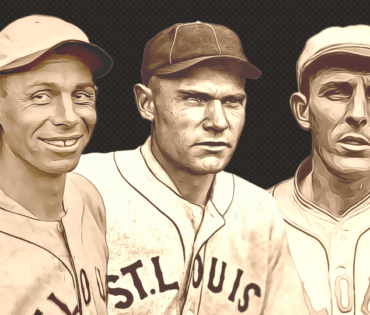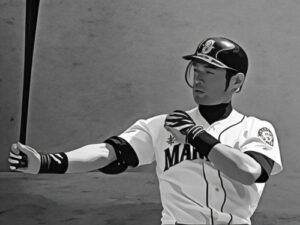Usually when teams form a talented outfield they patch it together with young players. But the St. Louis Browns built their famous outfield in the 1920s from three older castoffs who were denied a chance to play in other organizations. Slapped together on one of the weakest teams in the majors, the trio ended up being the longest-running outfield in baseball history and one of the most gifted.
Baby Doll Jacobson, center field
William Jacobson was in the middle of that famous outfield, surrounded by left fielder Ken Williams and right fielder Johnny “Jack” Tobin. By the time the three played their first game together on May 2, 1919, no one called Jacobson by his given first name. To everyone on a ballfield he was “Baby Doll,” a nickname bestowed on him by a female admirer in Mobile, Alabama in 1912 after he hit a leadoff home run. Prior to the first pitch of that game, a band had played the song “Oh, You Beautiful Doll.” a popular ragtime tune in those days.
Jacobson was very tall for his time, a shade over 6’3, and weighed more than 215 pounds. He had a barrel chest, thighs like fire hydrants, and a strong throwing arm. He was the best fielder of the three Browns’ outfielders by a long measure. The only right-handed hitter of the three outfielders, Jacobson used a heavy bat and aimed for the large gaps in left field at Sportsman’s Park. He hit a lot of doubles and triples and normally batted behind Williams. Baby Doll drove in 100 runs twice and hit over .340 three times.
Johnny “Jack” Tobin, right field
Tobin was the youngest and smallest of the three, a bit clumsy and slow to react in the outfield. He was the leadoff man, a slap hitter who could pull the ball or spray liners to the opposite field. He was an accomplished bunter, one sports writer observed, “Tobin can do more different things with a baseball bat than any man I have ever seen. I have seen him lay down and beat out a perfect bunt, then next time up whip one over the right-field fence.” The little leadoff man averaged 212 hits from 1920 to 1923. No one called him Jack, not his teammates, not the umpires, no one. On the field he was Johnny, the “Jack” materialized through a few newspaper articles.
“I was a .330 hitter most of my career. I’d bat .030 and bunt .300,” Tobin said once.
Tobin was one of the most skilled players in history at the drag bunt. He usually dropped down one per game, and he wouldn’t have been a .300 hitter without the weapon. He batted in front of Jacobson and Williams, the power hitter of the trio. In four consecutive seasons, all three outfielders hit over .300, from 1920 to 1923. In 1924, only Tobin missed the mark, and he batted .299 that year. Johnny was famous for having success against baseball’s hardest-throwing pitcher, Walter Johnson.
Ken Williams, left field
The left fielder, Ken Williams, was the slugger, born two months before Jacobson. He batted cleanup behind the great George Sisler. Williams used a 48-ounce bat but still managed to pull the ball, which helped greatly in their ballpark. In 1922 he hit 32 of his 39 homers at Sportsman’s Park. Williams posted a .319 career average, Tobin hit .309, and Jacobson hit .311 for his career.
Williams was the best of the three Browns’ outfielders, maturing into a strong hitter. In 1920, after a conversation with Babe Ruth before a game at Yankee Stadium, Williams switched to a heavier bat, settling on a 48-ounce piece of ash. Swinging that “wagon tongue” strengthened his upper body and in 1921, Williams hit 24 home runs, second in the league to Ruth. He may have also received a sneaky tip from the Babe: Williams reportedly plugged his bat to make it lighter, a tactic the Babe also used at times. The following season Williams was a demon, leading the league with 39 home runs and 155 runs batted in. By that time Williams was aiming for the right field seats at Sportsman’s Park, which were only 318 feet away in the right field power alley and 309 directly down the line. Williams hit 32 of his 39 home runs at home in 1922. Overall for his career with the Browns, Williams hit 72 percent of his home runs at Sportsman’s Park, the highest home percentage among batters who hit at least 150 home runs.
Years before the league moved defenders to the right side of the infield to foil Ted Williams, teams used the original “Williams Shift” against Ken. Both the shortstop and second baseman would move to the right of second base when Williams came to the plate, especially in St. Louis. The shift took some hits away, but it didn’t halt Williams from hitting .319 for his career. In 1925 Williams was having another noteworthy season at the plate, he had 25 homers and more than 100 RBIs by mid-August. But he was hit in the head by a pitch (after earlier hitting a home run in that same game) and his season ended after he spent ten days in a hospital with a serious concussion.
Williams got a late start to his career, his first full season came when he was 30 years old. But he still accomplished much: he was the first man to hit three home runs in a game in the American League; the first man to hit two home runs in one inning; the first batter to hit home runs in six straight games; and in 1922, his magnum opus, Williams became the first player in any major league to steal 30 bases and hit 30 home runs. He finished in the top four in home runs in his league in seven consecutive seasons, the last time when he was 37 years old. Once Williams finally got a chance to play in the big leagues, he looked around, saw what Babe Ruth and other sluggers were doing, and said to himself “I can do that too.” He wasn’t the Babe, but he was damn good.
Seasonal averages for the three Browns’ outfielders, from 1920 to 1924, their five full seasons together:
| G | AB | R | H | 2B | 3B | HR | RBI | AVG | OBP | SLG | ||
| Ken Williams | LF | 140 | 521 | 103 | 174 | 31 | 9 | 24 | 104 | .334 | .414 | .569 |
| Baby Doll Jacobson | CF | 150 | 587 | 91 | 194 | 33 | 12 | 10 | 98 | .331 | .377 | .480 |
| Johnny Tobin | RF | 146 | 619 | 105 | 203 | 32 | 12 | 6 | 62 | .329 | .378 | .458 |
It doesn’t matter what league you’re in or when you played, those numbers are impressive.






